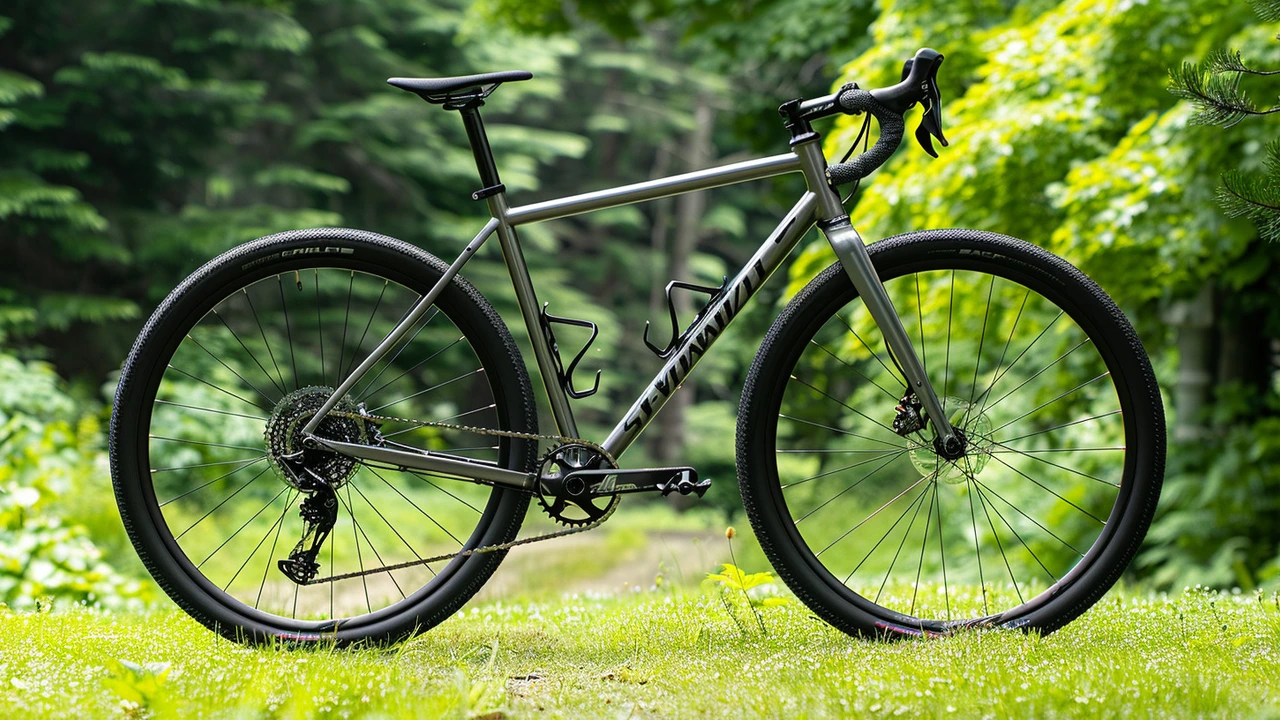Specialized Crux Alloy Returns with Advanced D'Aluisio Smartweld Technology
The reintroduction of the Specialized Crux Alloy, featuring the cutting-edge D'Aluisio Smartweld (DSW) technology, marks a significant milestone in the world of gravel bikes. This bike is not just a reincarnation; it is an evolution that sets a new benchmark in terms of weight, durability, and versatility. Weighing in at a mere 1399 grams for the frameset, the Crux Alloy now holds the title of the lightest alloy gravel bike ever manufactured. This achievement is a testament to the DSW technology, which employs hydroforming to create stronger and lighter welds, doubling the strength of the frame compared to traditional alloy frames.
From Cyclocross to Gravel Riding: A Shift in Focus
Originally designed with cyclocross racing in mind, the new iteration of the Crux has undergone a paradigm shift to prioritize gravel riding. This transition mirrors the growing popularity of gravel cycling, a discipline that offers a unique blend of adventure and endurance. Cyclocross courses are demanding, but gravel riding presents a different set of challenges, requiring a bike that can handle mixed terrains effortlessly. This pivot in focus ensures the Crux Alloy is not just a race machine but a versatile companion for long-distance gravel adventures and everything in between.
Innovative Construction: D'Aluisio Smartweld Technology
The D'Aluisio Smartweld technology stands at the heart of the new Crux Alloy. This innovative construction process uses hydroforming techniques to optimize the placement of material in critical areas, resulting in welds that are significantly stronger and lighter. The hydroforming process involves shaping the aluminum tubes with high-pressure hydraulic fluid, enabling the creation of intricate shapes and designs that would be impossible with traditional welding methods. The outcome is a frame that offers superior strength-to-weight ratio, enhancing both the durability and performance of the bike.
Premium Components for Enhanced Performance
The Specialized Crux Alloy comes equipped with top-tier components, ensuring that every ride is smooth and reliable. The bike features a full carbon Fact12r Crux fork that complements the lightweight frame, providing excellent shock absorption and precise handling. Additionally, the threaded bottom bracket enhances the bike's overall reliability and ease of maintenance. The SRAM UDH rear derailleur hanger offers enhanced shifting performance and compatibility with a wide range of drivetrains.
Seamless Shifting Systems and Zero Headtube Routing
One of the standout features of the new Crux Alloy is its compatibility with both mechanical and electronic shifting systems. This flexibility allows riders to customize their bike according to their specific preferences and riding style. The zero headtube routing further simplifies the setup process, making it easier for riders to service and maintain their bikes. This attention to detail reflects Specialized's commitment to providing riders with a hassle-free and enjoyable riding experience.
Geometry and Tire Clearance
The frame geometry and tire clearance of the Crux Alloy are identical to its carbon counterpart, offering a familiar and comfortable riding experience. The bike can accommodate up to 47mm tires on 700c wheels and up to 2.1-inch tires on 650b wheels. This versatility enables riders to tackle a wide range of terrains, from smooth gravel paths to rugged trails. The ample tire clearance also enhances stability and traction, providing confidence on challenging descents and technical sections.
Options and Pricing
The Crux DSW is available both as a complete bike and as a frame-only model, giving riders the option to build their dream bike from the ground up. The complete bike comes with an SRAM 12-speed Apex setup and weighs just 20 pounds in its lightest configuration. This setup offers a perfect balance of performance and value, making it an attractive option for both seasoned riders and newcomers to the gravel scene. The Crux Alloy is available for purchase immediately, with pricing starting at $2,600 for the complete bike and $1,700 for the frame.
A New Era for Gravel Bikes
The re-release of the Specialized Crux Alloy with D'Aluisio Smartweld technology marks the beginning of a new era for gravel bikes. By combining cutting-edge construction techniques with a rider-focused design, Specialized has created a bike that is not only incredibly light and durable but also exceptionally versatile. Whether you're a competitive racer or an adventure enthusiast, the Crux Alloy offers a level of performance and reliability that is hard to match. As gravel riding continues to grow in popularity, this bike is poised to become a favorite among riders looking for a capable and trustworthy companion for their off-road journeys.
In conclusion, the Specialized Crux Alloy is set to redefine the standards of gravel biking. Its innovative DSW technology, combined with thoughtful design and premium components, makes it a standout choice in the market. With its light weight, enhanced durability, and versatile performance, the Crux Alloy is ready to take on any gravel adventure you can throw at it. Don't miss out on the chance to experience this groundbreaking bike for yourself.







13 Comments
Wow, that Crux looks like a feather‑light ninja on a gravel road.
The Specialized Crux Alloy isn’t just a bike, it’s a manifesto of engineering hubris masquerading as progress. D’Aluisio Smartweld, with its hydro‑forming wizardry, claims to double strength, yet the physics of aluminum dictate diminishing returns once you start shaving grams off an already feather‑weight frame. One must ask whether the marginal weight savings truly translate into perceptible performance gains on the varied terrains that define gravel riding. The allure of a 1399‑gram frameset is undeniable for the obsessive gram‑counter, but the real world rewards durability and compliance over mere mass. Moreover, the decision to replace carbon’s nuanced ride quality with an alloy that still bears the hallmarks of rigidity may alienate riders seeking the supple feel that only carbon can provide. The decision to retain a carbon fork, however, introduces a hybrid character that feels indecisive, as if the designers could not commit to a singular material philosophy. The geometry being identical to its carbon sibling sounds sensible on paper, yet the distribution of mass and flex patterns differ fundamentally, leading to a distinct handling signature. The inclusion of both mechanical and electronic shifting compatibility is a clever marketing ploy, but it also fragments the product’s identity, leaving the consumer to wonder which system truly complements the frame’s character. Zero head‑tube routing simplifies maintenance, yes, but at the cost of losing the protective routing that shields cables from the harsh elements of gravel dust and mud. The tire clearance up to 47 mm is generous, but an alloy frame at such low weight may struggle to absorb the inevitable impacts, transferring vibrations to the rider in an unpleasant fashion. The price point, starting at $2,600 for the complete bike, positions it squarely between high‑end carbon rigs and budget‑ish aluminum models, making the value proposition murky. While the branding of “new era” sounds grandiose, history teaches us that incremental material tweaks rarely herald paradigm shifts in performance. In fact, the true revolution in gravel lies in software-mapping, route planning, and rider analytics-rather than marginal gains in tube thickness. Therefore, the Crux DSW should be celebrated not as a watershed moment but as a careful, perhaps overly cautious, iteration in Specialized’s product line. Riders who cherish the poetry of a lightweight frame will find it appealing, but those seeking holistic performance may be better served by looking elsewhere.
Jordan’s poetic fling overlooks the harsh reality that shaving a few grams seldom compensates for the compromised fatigue resistance that alloy, even when smart‑welded, inevitably suffers under prolonged gravel abuse.
Behold! The glorified steel dragon awakens, its sleek alloy sinews promising conquest across desolate dust‑strewn abysses, while the very notion of “lightness” becomes a siren song for the restless souls yearning to outrun their own shadows.
Indeed, the Crux’s hydro‑formed joints do improve stiffness‑to‑weight ratios, and the threaded bottom bracket should simplify service intervals; for riders prioritizing low‑maintenance builds, opting for the frame‑only version allows bespoke component choices tailored to specific terrain demands.
The Crux epitomises refined engineering
While many hail the DSW technology as a watershed, one could argue that the real breakthrough lies not in the welding technique but in the strategic decision to retain a carbon fork, thereby melding the best of two worlds rather than merely polishing an alloy chassis.
Ah, the paradox of progress, dear Cheryl, is that we celebrate incremental tweaks, the whisper of hydro‑formed seams, the glint of aluminum, yet overlook the soul‑deep yearning for a bicycle that sings in harmony with the terrain, a machine that, in its very essence, transcends mere materiality, and, in doing so, challenges the very foundations of what we deem “advancement”.
Sure, because a few grams saved will totally change how you “feel” the road.
Let’s cut through the noise-whether you’re an alloy aficionado or a carbon loyalist, the Crux’s versatile geometry and tire clearance give every rider a fair shot at tackling gravel, so the community should focus on real‑world testing rather than brand wars.
For cyclists aiming to push their limits, the Crux’s lightweight construction can serve as an empowering platform; by pairing disciplined training with this advanced frame, riders can achieve measurable gains in endurance and climbing efficiency.
In the grand tapestry of cycling evolution, the Specialized Crux stands as a testament to humanity’s relentless pursuit of marginal gains, reminding us that every gram shed is a reflection of our collective desire to transcend the constraints of physics and reimagine the boundaries of motion.
Excited to see how this bike performs on the next gravel adventure! 😊